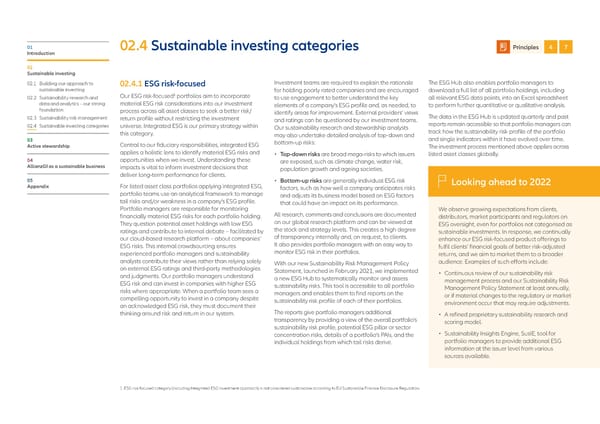01 02.4 Sustainable investing categories Principles 4 7 Introduction 02 Sustainable investing 02.1 B uilding our approach to 02.4.1 ESG risk-focused Investment teams are required to explain the rationale The ESG Hub also enables portfolio managers to sustainable investing for holding poorly rated companies and are encouraged download a full list of all portfolio holdings, including 1 02.2 S ustainability research and Our ESG risk-focused portfolios aim to incorporate to use engagement to better understand the key all relevant ESG data points, into an Excel spreadsheet data and analytics – our strong material ESG risk considerations into our investment elements of a company’s ESG profile and, as needed, to to perform further quantitative or qualitative analysis. foundation process across all asset classes to seek a better risk/ identify areas for improvement. External providers’ views 02.3 Sustainability risk management return profile without restricting the investment and ratings can be questioned by our investment teams. The data in the ESG Hub is updated quarterly and past 02.4 S ustainable investing categories universe. Integrated ESG is our primary strategy within Our sustainability research and stewardship analysts reports remain accessible so that portfolio managers can this category. may also undertake detailed analysis of top-down and track how the sustainability risk profile of the portfolio 03 bottom-up risks: and single indicators within it have evolved over time. Active stewardship Central to our fiduciary responsibilities, integrated ESG The investment process mentioned above applies across applies a holistic lens to identify material ESG risks and • Top-down risks are broad mega-risks to which issuers listed asset classes globally. 04 opportunities when we invest. Understanding these are exposed, such as climate change, water risk, AllianzGI as a sustainable business impacts is vital to inform investment decisions that population growth and ageing societies. deliver long-term performance for clients. 05 • Bottom-up risks are generally individual ESG risk Looking ahead to 2022 Appendix For listed asset class portfolios applying integrated ESG, factors, such as how well a company anticipates risks portfolio teams use an analytical framework to manage and adjusts its business model based on ESG factors tail risks and/or weakness in a company’s ESG profile. that could have an impact on its performance. Portfolio managers are responsible for monitoring We observe growing expectations from clients, financially material ESG risks for each portfolio holding. All research, comments and conclusions are documented distributors, market participants and regulators on They question potential asset holdings with low ESG on our global research platform and can be viewed at ESG oversight, even for portfolios not categorised as ratings and contribute to internal debate – facilitated by the stock and strategy levels. This creates a high degree sustainable investments. In response, we continually our cloud-based research platform – about companies’ of transparency internally and, on request, to clients. enhance our ESG risk-focused product offerings to ESG risks. This internal crowdsourcing ensures It also provides portfolio managers with an easy way to fulfil clients’ financial goals of better risk-adjusted experienced portfolio managers and sustainability monitor ESG risk in their portfolios. returns, and we aim to market them to a broader analysts contribute their views rather than relying solely With our new Sustainability Risk Management Policy audience. Examples of such efforts include: on external ESG ratings and third-party methodologies Statement, launched in February 2021, we implemented • Continuous review of our sustainability risk and judgments. Our portfolio managers understand a new ESG Hub to systematically monitor and assess management process and our Sustainability Risk ESG risk and can invest in companies with higher ESG sustainability risks. This tool is accessible to all portfolio Management Policy Statement at least annually, risks where appropriate. When a portfolio team sees a managers and enables them to find reports on the or if material changes to the regulatory or market compelling opportunity to invest in a company despite sustainability risk profile of each of their portfolios. environment occur that may require adjustments. an acknowledged ESG risk, they must document their thinking around risk and return in our system. The reports give portfolio managers additional • A refined proprietary sustainability research and transparency by providing a view of the overall portfolio’s scoring model. sustainability risk profile, potential ESG pillar or sector concentration risks, details of a portfolio’s PAIs, and the • Sustainability Insights Engine, SusIE, tool for individual holdings from which tail risks derive. portfolio managers to provide additional ESG information at the issuer level from various sources available. 1 ESG risk-focused category (including Integrated ESG investment approach) is not considered sustainable according to EU Sustainable Finance Disclosure Regulation.
 Allianz GI Sustainability and Stewardship Report 2021 Page 31 Page 33
Allianz GI Sustainability and Stewardship Report 2021 Page 31 Page 33